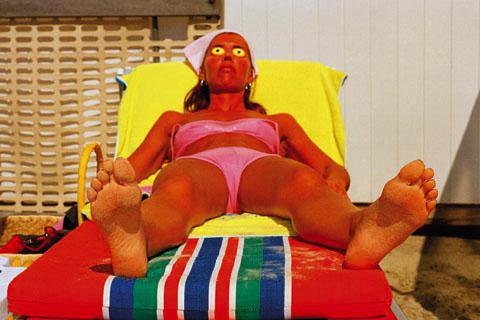When shooting with black and white film, you are able to use filters which allow only certain colours to pass through them but block other colours. For example, a Red filter…. If you hold a red rose up to a bright blue sky, the red filter will allow all of the light from the rose petals to pass through, however, it will block out most of the blue light from the sky. This will end in a photograph with a bright rose and a very dark sky.
Red Filter: These are attached to your camera lens.
You are able to use filters when shooting with a digital camera, however, processing programmes are much easier to process your final images, rather than using filters there and then.
Exercise:
For this exercise, you were advised to find a small groups of objects which were GREEN, YELLOW AND RED. You were also asked to include a Grey piece of card. As I would be using a digital camera, I would only need to take one photograph. After I take the one photograph, I would then use Photoshop to add the different filters as required.
I decided to stick to the Peppers which were an example in our study book. Rather than using a piece of grey card, I decided to use a grey piece of material to place the peppers on.
Original Image: No Filter
Default Black and White: No Filter.
Red Filter:
Yellow Filter:
Blue Filter:
Green Filter:
Overall Opinion:
Being honest, I found this exercise difficult, mainly because I hadn’t used my Photoshop before so I had to know how to use the filters. I looked everywhere for help to explain how to add the filters and I asked my tutor. I took her advice, however I still think im doing something wrong. I have been looking at other blogs and I can see how the filters work on other peoples photographs, and how they don’t on mine. I am still confused with this exercise so it would definitely be something I would have to play around with in order for me to learn how to add filters to my image more. I would perhaps have to experiment with a 35mm film camera and filters in order to get the correct final images.
Looking at some other blogs, I can see how when you add a filter to your image, it can completely change the look of a colour. It can make the tones either lighter or darker, and you are able to change selected parts of an image, just by choosing the right colour and filter.
I would like to understand how to add a filter properly so if anyone reading this could help, that would be hugely appreciated. I am using Photoshop Elements 9.
After letting this exercise stew over night, I decided to re-do it, as I did not want to let it beat me. I went back onto my Photoshop and began from the beginning. I converted the image to black and white. I then moved the RGB cursers depending on what colour filter I wanted mainly. I began with the Red curser. I moved it to the end, which meant it was mainly red. I then moved the green and blue cursers making sure that the red was the main filter for the image. I carried on with blue and green. I have included the updated photographs with the correct filters.
Updated Images:
Red Filter:
Blue Filter:
Green Filter:
Yellow Filter:
Overall Opinion:
I am a lot happier with how this has turned out now. I am pleased that I managed to understand how to change the filters. I can definitely see how changing one colour can influence a photograph and the colour tones.




































